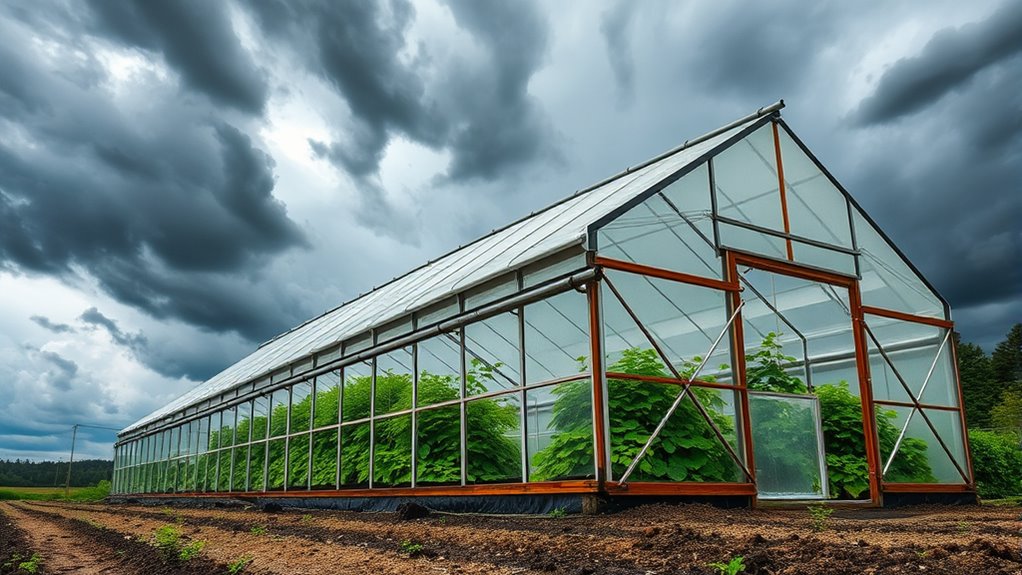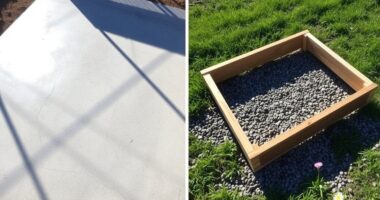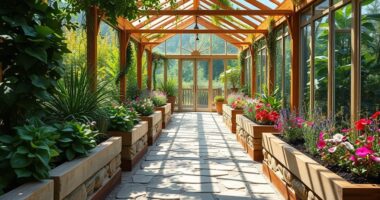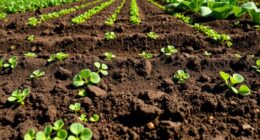To anchor your greenhouse against wind and storms, start with a solid foundation like concrete for added stability. Use ground anchors twisted into the earth and secure framing with diagonal cross bracing. Consider embedding rebar at 45 degrees for extra support. Seal gaps to prevent drafts and brace critical points effectively. Regularly inspect and maintain your structure to guarantee it withstands extreme weather. There are even more strategies to enhance your greenhouse’s resilience.
Key Takeaways
- Choose a solid foundation, such as concrete, to provide added weight and stability against strong winds and storms.
- Use ground anchors that are twisted or hammered into the earth for secure framing and stability.
- Implement diagonal cross bracing with durable metal rods to prevent twisting and enhance structural integrity in high winds.
- Seal gaps with silicone sealant to prevent drafts and protect your greenhouse from wind penetration during storms.
- Regularly inspect and maintain structural integrity to ensure all components are secure and functioning properly before severe weather events.
Choosing the Right Location for Your Greenhouse
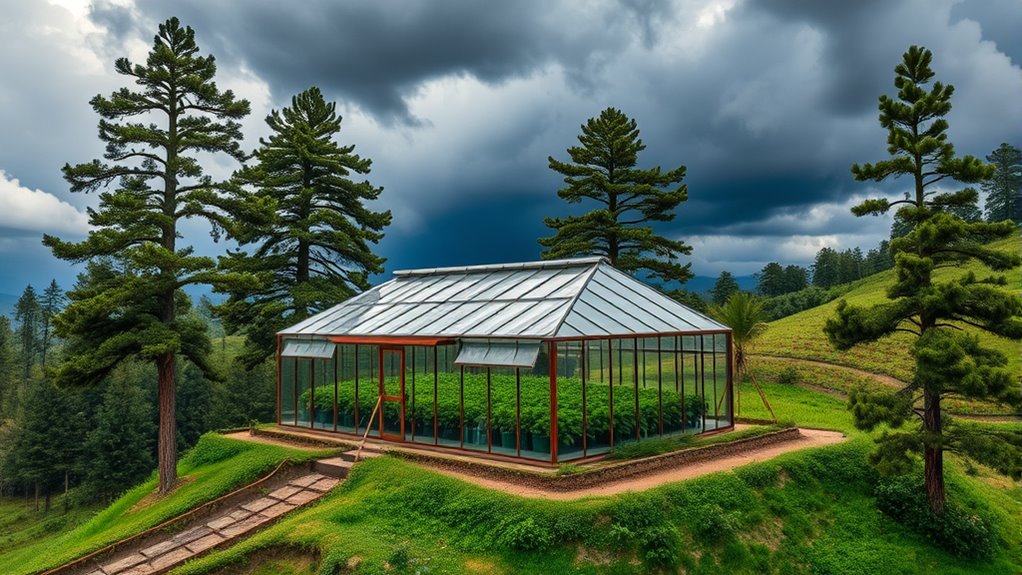
When selecting the perfect spot for your greenhouse, how do you guarantee it meets all your needs?
Start by ensuring it gets at least six hours of sunlight daily, ideally facing south if you’re in the Northern Hemisphere. This orientation maximizes light exposure year-round. Avoid areas with too much shade from trees or buildings, and consider supplemental grow lights if natural sunlight isn’t enough.
Next, think about accessibility. Position your greenhouse near water and electricity sources for convenience, and keep pathways well-maintained for easy access.
Make sure the soil is fertile and well-draining, and choose a flat or slightly sloping area to avoid drainage issues.
With these factors in mind, you’ll create a thriving environment for your plants.
Understanding Local Wind Patterns

Understanding local wind patterns is vital for ensuring your greenhouse can withstand the elements. Wind speed varies considerably, reaching up to 150 mph in some areas, so knowing your region’s specifics is essential.
Pay attention to wind direction; orienting your greenhouse to face prevailing winds minimizes impact. Utilize regional wind maps to assess potential wind loads based on your greenhouse’s height and surroundings.
Remember that seasonal changes can alter wind patterns, affecting stability. Evaluate how positive and negative pressures can stress your structure, especially if openings aren’t secured.
Selecting Wind-Resistant Materials
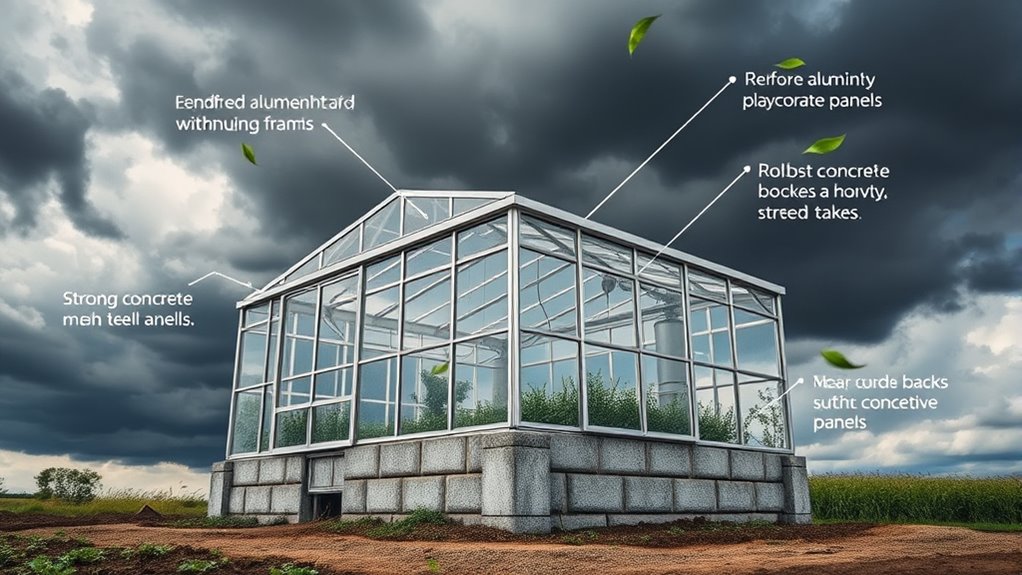
Selecting wind-resistant materials is essential to ensuring your greenhouse can endure harsh weather conditions. Opt for polycarbonate panels due to their lightweight and impact resistance. Toughened safety glass is another great choice, offering strength in larger panes. For frames, consider metal like steel for a sturdy base or durable woods like larch for natural resistance. Additionally, incorporating wind-resistant materials can significantly enhance the durability of your greenhouse against severe weather.
Here’s a quick comparison of materials:
| Material | Benefits |
|---|---|
| Polycarbonate Panels | Lightweight, impact-resistant |
| Toughened Glass | Stronger, larger panes |
| Metal Frames | Sturdy, enhances stability |
| Wooden Frames | Naturally resistant, durable |
Effective Anchoring Techniques

To guarantee your greenhouse withstands strong winds and adverse weather, effective anchoring techniques are essential.
Start by choosing a solid foundation, like concrete, which adds weight and stability. Ground anchors can be twisted or hammered into the earth, securing your greenhouse frame effectively.
For a simple solution, consider using rebar at a 45-degree angle through timbers for added support. The timber and L-bolt method also provides strength by anchoring timbers in concrete.
Additionally, the rope-and-rebar method ties cedar posts to rebar, enhancing stability. Regularly inspect and tighten these anchors to ascertain they remain secure.
Windproofing the Structure
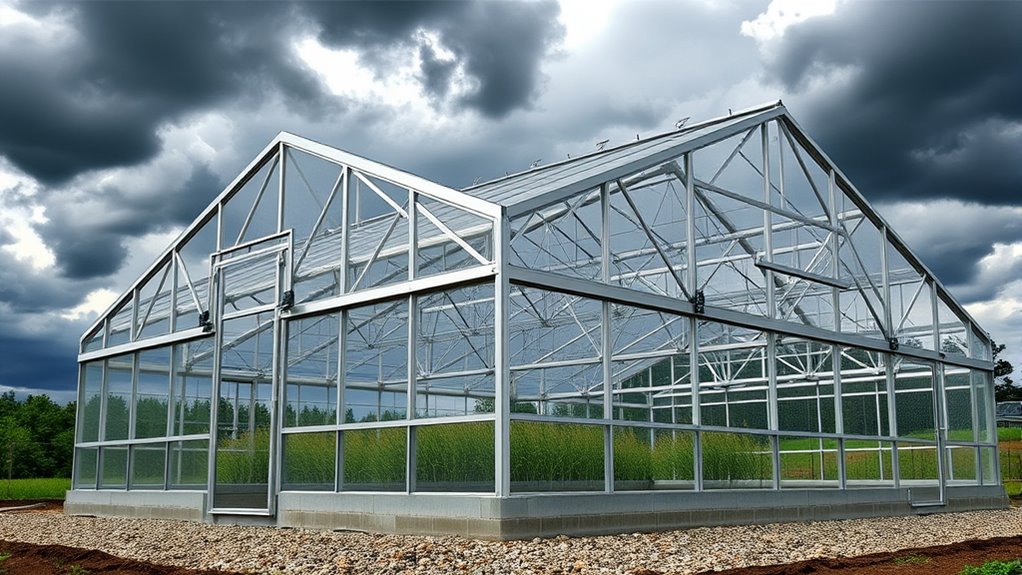
To guarantee your greenhouse can withstand strong winds, focus on secure glazing techniques and effective reinforcement methods.
Using high-quality materials for windows and adding structural supports can make a significant difference in stability.
Let’s explore how these strategies will help protect your greenhouse from wind damage.
Secure Glazing Techniques
When it comes to securing glazing in your greenhouse, choosing the right materials is essential for windproofing the structure. Opt for tougher options like safety glass or high-strength films, which resist wind damage better than polycarbonate.
To guarantee your glazing stays intact, consider these techniques:
- Use clips or glazing tape to firmly attach panels to the frame.
- Apply glazing repair tape on both sides of overlapping panes for extra protection.
- Seal gaps with silicone sealant for a more permanent solution.
- Regularly inspect and replace damaged or missing panes promptly.
Additionally, incorporating AI technologies can help analyze local weather patterns to better prepare your greenhouse for storms. Understanding backyard greenhouse construction principles can also enhance the overall stability of your structure.
Reinforcement Methods
While securing your greenhouse against wind damage, incorporating effective reinforcement methods is essential. Start by using deep foundation embedding for stability, considering soil conditions. Reinforce the structure with cross bracing and roof bracing to prevent twisting and distribute wind pressure. You can also enhance durability by using galvanized steel pipes for the frame and adding wind-resistant columns at both ends.
| Method | Description |
|---|---|
| Deep Foundation Embedding | Enhances stability in varying soil conditions |
| Cross Bracing | Prevents twisting during strong winds |
| Roof Bracing | Distributes wind pressure evenly |
| Galvanized Steel Frame | Increases load-bearing capacity |
| Wind-Resistant Columns | Adds stability and support |
Implementing Protective Measures

Implementing protective measures is essential for ensuring your greenhouse withstands harsh weather conditions.
Start by selecting an ideal location that takes advantage of natural windbreaks while ensuring adequate sunlight. Next, choose materials wisely; polycarbonate panels or tempered glass offer resilience against winds.
Here are four key measures to implement:
- Cross Bracing: Reinforce the structure to prevent twisting in strong winds.
- Seal Gaps: Use silicone sealant around panels and frames to keep out drafts.
- Windbreaks: Plant conifer trees or install storm fencing to deflect wind.
- Regular Maintenance: Inspect your greenhouse post-storm for any damage and make necessary repairs.
These steps will greatly enhance your greenhouse’s ability to endure severe weather.
Preparing for Extreme Weather Conditions
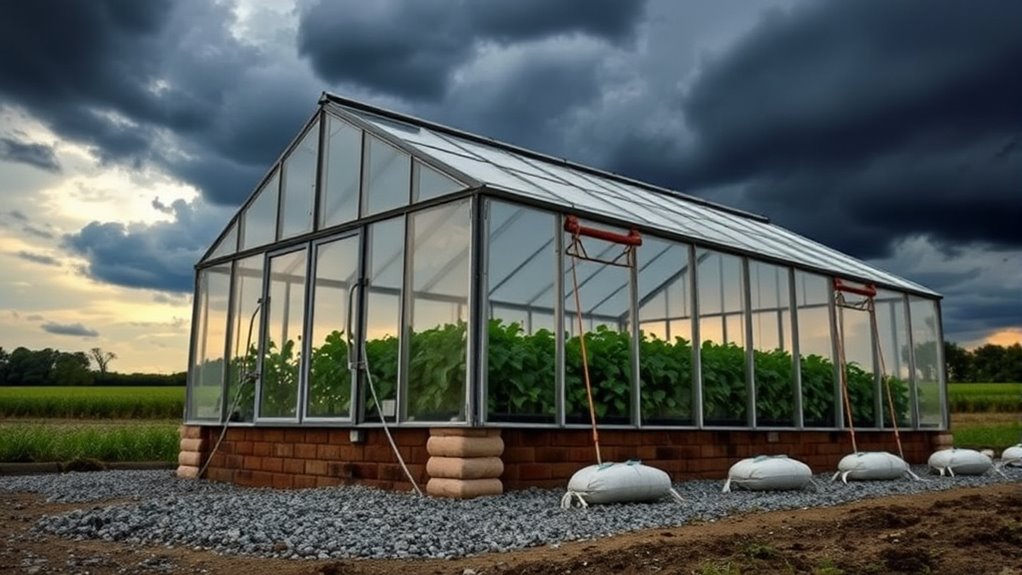
When preparing for extreme weather, you need to focus on strengthening your greenhouse’s foundation.
Make sure your heating systems are well-maintained to protect your plants in case of power outages.
It’s also wise to have an emergency backup plan ready to guarantee you’re prepared for any situation that arises.
Strengthen Foundation Stability
To guarantee your greenhouse stands strong against extreme weather, selecting the right foundation is essential. A solid foundation not only supports your structure but also enhances stability against wind and storms.
Here are four effective strategies to strengthen your foundation:
- Choose Concrete Foundations: They offer unmatched durability and strength.
- Utilize Soil Anchors: Spiral anchors or weighted base plates can greatly improve stability on soil bases.
- Opt for Hard-Standing Bases: These provide solid support, making it easier to keep your greenhouse level.
- Consider Raised Foundations: Perfect for low-lying areas, they help prevent flooding.
Maintain Heating Systems
Effective heating system maintenance is vital for keeping your greenhouse thriving during extreme weather conditions.
Start by choosing the right heating system for your space. Electric heaters work well for smaller areas, while gas heaters are better suited for larger greenhouses, provided you verify proper ventilation.
Consider eco-friendly solar heaters for long-term savings, or infrared heaters to deliver direct warmth to your plants without drying them out.
Insulate with polycarbonate panels or bubble wrap to trap heat effectively. Don’t forget to install thermal curtains to reduce heat loss overnight.
Regularly check your ventilation systems, as proper airflow and humidity management are essential for plant health, especially during storms.
Staying proactive with these measures will help maintain a stable growing environment.
Prepare Emergency Backup Plans
Preparing for extreme weather conditions requires a proactive approach to guarantee your greenhouse remains safe and operational.
Establishing a solid emergency backup plan is essential. Here are some key steps to take into account:
- Identify Risks: Know the common weather hazards in your area and assess your greenhouse’s vulnerability to them.
- Create a Thorough Plan: Develop a pre- and post-storm operation strategy that everyone understands.
- Involve Your Team: Involve employees from all departments in the planning process for diverse insights and support.
- Conduct Regular Drills: Test your emergency procedures frequently to ensure everyone knows their roles during a crisis. Additionally, remember to set boundaries to protect personal time and space during the stress of extreme weather.
Regular Maintenance and Inspections

Regular maintenance and inspections are essential for guaranteeing your greenhouse remains a safe and productive environment for your plants.
Start by checking the structural integrity of the frame for wear, rust, or damage. Tighten all bolts and screws to maintain stability. Inspect glass panels for cracks or loose fittings, and assess the foundation for erosion.
Evaluate your drainage system to verify it’s functioning properly. Don’t forget to make preventive repairs; use poly repair tape for tears, silicone sealant for glass panes, and weather stripping around doors.
Secure equipment and lower shelving to prevent tipping. Finally, clear the surrounding area of debris and prune branches to minimize potential hazards during storms.
Regular checks can save you time and resources in the long run.
Enhancing Stability With Bracing

To keep your greenhouse secure, consider implementing diagonal cross bracing and roof reinforcement techniques.
Cross bracing helps prevent twisting during strong winds, while roof reinforcement guarantees stability against heavy pressure.
Together, these methods enhance your greenhouse’s ability to withstand extreme weather conditions.
Diagonal Cross Bracing
As strong winds can pose a significant threat to your greenhouse, implementing diagonal cross bracing is an essential step in enhancing its stability.
This technique involves installing diagonal bars across the frame, increasing rigidity and preventing twisting.
Here’s why you should consider it:
- Structural Support: Diagonal bracing reinforces the frame, making it less prone to wind damage.
- Material Options: You can use durable metal rods or bars for effective bracing.
- Strategic Placement: Install bars at key points to maximize support and stability.
- Cost-Effective: It’s a budget-friendly method compared to other reinforcement techniques.
Roof Reinforcement Techniques
While strong winds and heavy snow can threaten your greenhouse, implementing roof reinforcement techniques is vital for maintaining its stability.
Start by adding internal support frames to your polycarbonate roof, which can reduce the risk of cracking. Consider covering your greenhouse with a durable tarp to protect against snow buildup.
Use metal rods for bracing to help distribute wind pressure evenly across the structure. Strengthen your roof vents by closing them during storms and securing them with fasteners.
Regular inspections are important to guarantee all reinforcements remain effective. Additionally, ensuring that air quality remains optimal within the greenhouse can further support plant health, as improved air quality contributes to overall resilience. By taking these steps, you’ll enhance your greenhouse’s resilience, ensuring it can withstand the elements and continue to thrive.
Storm Preparation Strategies

When preparing your greenhouse for an impending storm, focusing on strategic measures can greatly reduce the risk of damage. Here are some key steps to take:
- Secure Doors and Windows: Close and lock all doors and windows to prevent wind from entering.
- Clear Surroundings: Remove loose items and debris around the greenhouse to minimize flying hazards.
- Prune Vegetation: Trim any nearby branches that could fall and cause damage during the storm.
- Monitor Weather: Stay updated on forecasts to anticipate the storm’s timing and intensity.
Frequently Asked Questions
What Are the Best Plants for Windy Greenhouse Environments?
When selecting plants for a windy greenhouse, you’ll want to choose flexible and sturdy varieties.
Consider Dracaenas and grasses for their pliability or opt for short, robust plants like geraniums and Alchemilla mollis.
Small-leaf plants, such as petunias and marigolds, catch less wind, minimizing damage.
Native plants, like switch grass, naturally adapt to windy conditions, while durable shrubs like viburnum can provide additional shelter.
This way, your greenhouse remains a thriving environment.
How Can I Reinforce Existing Greenhouse Structures Against Wind?
To reinforce your existing greenhouse structure against wind, start by installing cross-bracing for added stability.
Check your frame connections and tighten any loose bolts to enhance integrity.
Consider adding diagonal braces and reinforcing the roof with metal rods.
Ascertain the foundation’s secure by embedding it deeply and using heavy-duty anchors.
Regularly inspect for weak points and make necessary adjustments.
Don’t forget to remove debris around your greenhouse to minimize wind damage risks.
Are There Insurance Options for Greenhouse Storm Damage?
Yes, there are several insurance options for greenhouse storm damage.
You can choose property coverage to protect your structure, along with crop protection to cover losses from weather-related damage.
Business interruption insurance helps you manage losses if operations halt.
Additionally, equipment coverage safeguards your essential tools.
Remember to assess your specific needs and consider liability and workers’ compensation coverage to guarantee thorough protection for your greenhouse and business operations.
What Is the Best Time of Year to Secure My Greenhouse?
Spring and fall are tricky seasons with unpredictable weather, while winter storms can weigh down your structure.
You’ll want to secure your greenhouse during these times to prevent damage. Regular inspections and maintenance year-round keep it sturdy, but pay extra attention right before storms.
When you anticipate severe weather, take your precautions seriously. By staying proactive, you guarantee your greenhouse remains safe and your plants thrive through all seasons.
Can I Use Recycled Materials for Greenhouse Construction?
Yes, you can definitely use recycled materials for greenhouse construction!
You’ll find that sourcing items like old windows, doors, and lumber from local building sites or Habitat for Humanity can save you money while being environmentally friendly.
Plus, using recycled wood from pallets for framing adds character.
Just make certain the materials are sturdy and suitable for your greenhouse design to guarantee durability and functionality in the long run.
Conclusion
In the face of nature’s tempests, your greenhouse can stand resilient like an oak tree amidst a storm. By choosing the right location, selecting sturdy materials, and employing effective anchoring techniques, you create a sanctuary for your plants. Regular maintenance and storm preparation are your guardian angels, ensuring your greenhouse remains a safe haven. Embrace these strategies, and let your greenhouse thrive, no matter how fiercely the winds may howl. Your plants deserve a fortress, so build it wisely.
